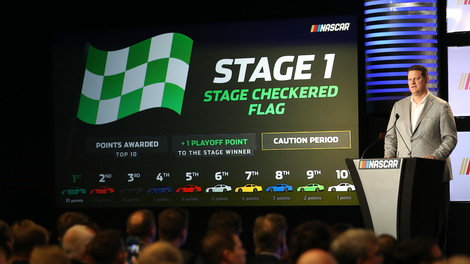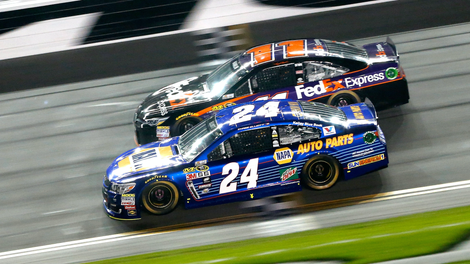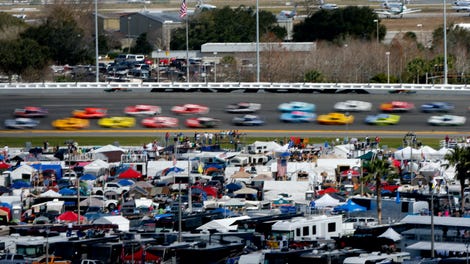
The biggest day in American stock-car racing is here, and you may have noticed that it’s going to look a whole lot different—and more complicated—this time around. Luckily, we’ve got your back. Here’s a breakdown of everything you need to know about the Daytona 500 and the 2017 NASCAR season.
Last time all of the cars in NASCAR’s top series were on track at once for a points race, things were a lot different. The series’ title sponsor was Sprint, Jimmie Johnson was on his way to a seventh championship, teams could do almost whatever they needed to fix a wrecked race car, and NASCAR races weren’t chopped up into “stages.”
But here we are, three months later, with NASCAR wearing a completely new identity about as well as we all did when going through “one of those phases” in middle school. Let’s talk about just how different things will be when the cars hit the track.
The New Rules
Take a deep breath. Find your happy place. Get ready for a major overload of information on the new NASCAR points system, because it will be thrown at you in approximately two paragraphs. Feel free to scroll over this part if you don’t care about the intricacies of NASCAR points and just want to understand the bigger picture.
The now-named Monster Energy NASCAR Cup Series—as well as the other two divisions included in NASCAR’s top-three national touring series, the Xfinity Series and Camping World Truck Series—all have a lot of new rules now that it’s 2017, and it may take a minute to grasp it all.
At its most basic, the new NASCAR format across all three series features three segments per race. Those segments are officially referred to as “stages,” and the first two stages in each race will end with a newly introduced green-and-white checkered flag. The final stage will, of course, end with the checkered flag we all know and love. Stages at each different track will differ in length, and the full lineup of stage lengths for 2017 can be found here.
The new points system
The top-10 drivers in the running order at the end of each stage will receive additional points toward the championship, and the winner of each stage and the race overall will receive “playoff” points. Playoff points differ from regular ones in that drivers will get to carry them over into the championship playoffs, which is the thing that’s been known as the “Chase” for more than 10 years.
That’s gone now. It’s just the “playoffs,” kind of like the “overtime” NASCAR introduced last year.
Back to the points. Until this year, the concept of playoff points only applied to bonus points drivers carried over into the postseason for number of race wins during the regular season. For the 2017 season, drivers can collect playoff points to carry into the postseason by the means of stage finishes, the regular-season points standings, as well as race wins.
In addition to regular-season points, here’s how the playoff point system will work: drivers who win an in-race stage will receive one playoff point, drivers who win a race will receive five playoff points, the winner of the regular-season points championship will receive 15 playoff points, and the rest of the top-10 drivers in the standings at the end of the regular season will also get a few.
Playoff points only matter for drivers who make the playoffs, and their points totals will be reset to 2,000 at the start of the first round of 16 drivers. The playoff points are then added to that 2,000 total.
Stop. Breathe. Take a minute. Re-read this section if you need to do so. But also take comfort in the fact that you can enjoy cars racing without understanding the points system.
That being said, let’s talk about more points. NASCAR decided to award points for finishing positions in the two qualifying races for the Daytona 500, the Can-Am Duels, for the first time since 1971 this year. That means that the winners of those races, Denny Hamlin and Daytona 500 pole-sitter Chase Elliott, are the current Cup Series points leaders at 10 apiece. The qualifying races only happen for the Daytona 500, so this rule won’t apply again this season.
Under the new rules, drivers will no longer receive a point for leading a lap or leading the most laps as they have in the past. Poof, gone, out the window.
The regular points—not the playoff ones that are carried over—awarded at the end of a race also changed for 2017. Several years after NASCAR simplified the points system to decreasing by one point per driver plus a few bonus for the winner, it now goes as follows: winner receives 40 regular points, second place gets 35 and it decreases by one point per position from there. Once it hits one, every finisher after that position also receives one regular point.
The only time points won’t matter at all is in the championship race, and it’s been that way since the introduction of NASCAR’s knockout playoff format a few years ago. All four drivers remaining in the title hunt in the season finale will start at the same amount of points, and the top finisher in the final race of the year at Homestead-Miami Speedway will win the championship.
The introduction, and the loss, of in-race time clocks
The other major rule change for the 2017 season was NASCAR’s stance on in-race car repairs. Teams now have a five-minute clock to make initial repairs on a vehicle that will allow it to do the minimum speed for the particular race track that it’s at, and if they cannot do so, they’re done for the day.
If a car goes into the garage, it can’t come back. It’s done for the day. Teams also can’t replace body panels during the race, so a major wreck will essentially end a driver’s race.
A last change applies only to the NASCAR Camping World Truck Series, which ran its first race of the season on Friday night. After a single season of using the 20-minute “caution clock” introduced in 2016, the clock is gone. The stages now act as the clock.
The Rules NASCAR Decided To Keep Around
Like it has for the past few years, NASCAR’s 10-race playoffs will consist of several knockout rounds. The first three rounds of the playoffs will be three races apiece, and the final round is simply the season finale at Homestead-Miami Speedway. Wins in each round propel a driver automatically to the next.
The playoffs will start with 16 qualifying drivers, and four will be eliminated after the first “round”of races. Three more races, four more drivers go out. Three more races, another four eliminations. Four will remain at the end, and finishing positions in a single race in Homestead will decide the championship title. What makes things even weirder, this year, are those repair rules from earlier—imagine all four contenders getting into a bad, but fixable in more than five minutes, wreck at the same time. Yikes.
Since the points configuration in that knockout format tends to reward race wins over consistency, the new stage-based format seemed like a backtracking by NASCAR to make consistency more important throughout the season. But that backtracking came with a lot of confusing rules, as you can tell.
The overtime rule, which is just a ball-sport way to describe the beloved green-white-checkered finish, is also still around. For those unfamiliar, a GWC finish consists of a green-flag lap, the white-flag lap and then the finish. It’s just two laps to end a race if there’s a late caution.
But NASCAR introduced “overtime” in 2016, and it actually makes for a shorter window for a potential caution to come out in the midst of the renamed green-white-checkered finish. Each track has a different “overtime line,” and as soon as drivers reach it on the green-flag lap of a green-white-checkered, the next flag ends it. The white flag used to be the point at which the next flag ended it, but NASCAR moved that point up.
How Things Have Played Out So Far
The NASCAR Camping World Truck Series and Xfinity Series have already begun their season under the new race and championship formats, and things haven’t been a huge, huge train wreck so far. There have been a lot of wrecks, but the new system, overall, hasn’t caused the zombie apocalypse yet.
The points: Not the worst thing in the world
There have been a few positives so far. If the Camping World Truck Series race from Friday night is any evidence, the new points format at least did what the sanctioning body intended it to do in Johnny Sauter’s situation. After winning the first two stages of the race, a late wreck collected Sauter and dropped him all the way to 15th in the final running order. But because of the two stage wins throughout the race, Sauter wound up second in the standings after the race—by means of complicated calculus equations due to the points system, of course.
But still, the new points system allowed Sauter to take credit for how well he ran during the entire race rather than just at the end. And, even if it took a lot of complicated rules to get there, that’s a positive.
It counteracts the cutthroat, “what can you do for me now” points system that NASCAR’s knockout format brought about. William Byron, the dominant entry for the Camping World Truck Series throughout 2016 who won nearly a third of the races, lost out on a shot at the championship during the final round of the Chase last year (back when it was still called that) due to a blown engine.
It showed a major flaw in the system—one that we already knew was there, but still—and awarding points throughout a race could help that kind of thing. There’s likely a less confusing way to do all of that, but at least it helps fix some of the problems caused by the all-important (to NASCAR) knockout system.
The repair clock: Maybe the worst thing in the world
While the points actually played out better than expected, the repair clock was not as fun. It added an extra point of confusion and explanation after every large wreck, a common event at Daytona, in the commentators having to explain and track each driver and team in the pits trying to thrash their car back together and get it onto the track before the clock ran out.
Add the time penalties that NASCAR introduced for certain infractions during car repairs, and things were just a bit chaotic.
There was also no coverage of feverous repairs in the garage, because there’s now no return from the garage once a driver heads in. That’s an element of a NASCAR broadcast that’s always enjoyable, for multiple reasons: people who don’t watch anything but the race get to see inside the garage, and the whole atmosphere around a big repair is just fun, whether it be interviewing drivers who are still in the car or showing just how hard teams work to get back out on track and get a few points for finishing two places higher in the running order.
The stages: Did they really matter?
In the case of Daytona, no, the stages didn’t really matter. There were so many cautions during the first two races of the weekend that it was hard to tell stage end from caution, and the cautions kept there from being any real “races” to get those bonus points at the end of a stage. The first two stages in the Xfinity race, for example, both ended under caution despite NASCAR’s attempts to end them under green.
But that’s likely just because the stage format debuted on a track at which NASCAR doesn’t need artificial breaks in the action. There are enough wrecks and such at Daytona to bring cautions out anyway, so it led to a lackluster debut for the artificial stoppages.
At other places, however, the stages could be less confusing and actually mean something. There could be some really great races to get the bonus points for good finishes in a stage, but we’ll just have to see how it plays out.
How To Make Sense Of It All
Just watch, honestly. Try to enjoy it. The broadcast will display points at the end of the race, and even if you don’t know how drivers got the amount of points they did, it won’t change anything. This is the direction NASCAR decided to go in, and if we want to watch, we’re just going to have to accept it.
If not, it probably won’t go unnoticed.






